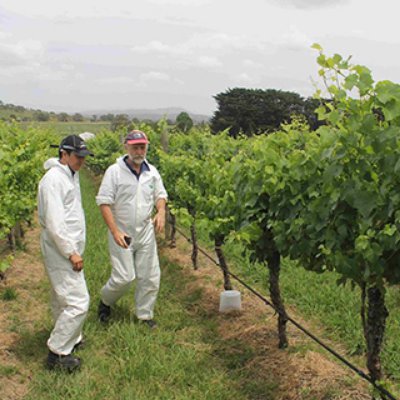 Leading scientists from Australia and the US have formed a partnership to research the role remote sensing and Unmanned Aerial Vehicles (UAVs) could play in improving surveillance capabilities for plant pests.
Leading scientists from Australia and the US have formed a partnership to research the role remote sensing and Unmanned Aerial Vehicles (UAVs) could play in improving surveillance capabilities for plant pests.
The multi-million dollar project is funded by the Plant Biosecurity Cooperative Research Centre (PBCRC) – of which the Department of Economic Development, Jobs, Transport and Resources (DEDJTR) is a core partner.
DEDJTR scientists are studying the root-feeding grape phylloxera, which is a highly destructive pest of grapevines. Leading the research team in Victoria is Dr John Weiss (a senior research scientist with DEDJTR based at the AgriBio Centre for AgriBioscience). Weiss works closely with a colleague from DEDJTR’s Rutherglen research facility, Dr Kevin Powell (a principal research scientist and an international expert on grape phylloxera).
The tiniest insect – Victoria’s biggest grapevine biosecurity threat
According to Weiss and Powell, phylloxera poses the biggest endemic biosecurity threat to the livelihood of Victoria’s viticulturists and the state’s billion-dollar wine industry.
Originally from North America and found in every wine producing country in the world except Chile, phylloxera is a minuscule insect that made its way to Geelong in 1875, and is currently only found in some areas of central and north-eastern Victoria and south east of New South Wales. Although it can be managed through the effective use of quarantine and resistant rootstocks, early detection is vital for these measures to work well, and to reduce the risk of further spread.
Australia-first study
Australia leads the world in looking at new approaches for detecting phylloxera, including hyperspectral remote sensing, but this is the first time remote sensing using hyper-spectral cameras mounted on drones has ever been trialled for phylloxera.
“Victoria has world-class quarantine practices, but we need to detect phylloxera earlier,” explained Weiss.
On average it takes around three to five years for a grapegrower to detect infestation of phylloxera (leaf discolouration and reduced canopy vigour are some of the tell-tale signs). By that time, the vine starts to die due to the insect destroying the root system, and it will not recover. The only option is to remove vines and replant onto resistant rootstocks.
“Hyper-spectral cameras can pick up thousands of gradients of colour,” said Weiss, “so they really start to pull things apart that we can’t see with the human eye. By mounting hyperspectral cameras on UAVs, we can very quickly scan an enormous area for early signs of phylloxera infestation, and identify smaller priority areas for intensive ground-based studies.”
Significant economic impacts
The economic impact of phylloxera is considerable. It costs grapegrowers up to $55,000/hectare to replant on resistant rootstocks and put suitable quarantine infrastructure in place. The total cost facing grapegrowers is already in the tens of millions of dollars– and this doesn’t include the loss of production.
Emerging technologies – a step forward to protecting Victoria’s thriving wine industry
Victoria’s grape and wine industry employs over 12,000 people and is worth over $1.5 billion to the economy. The flow on benefits from the grape and wine industry cover a wide spectrum of industry sectors, including agriculture, retail, hospitality, and tourism – estimated to be worth over $3.5 billion per year to the state’s economy.
Phylloxera is still actively spreading. According to Wine Yarra Valley, infested hectares could potentially double by 2018, which is why early detection is critical in preventing its spread.
“The PBCRC project is not only looking at what tools to use, it’s really aiming at end-user engagement,” explained Weiss, “An important aim is to provide grapegrowers with useful information about the best time of year to use these tools, and what they need to be looking for in a hyperspectral analysis.”
The PBCRC project is now in its final (third) year of research into the effectiveness of UAVs as surveillance tools for plant pests including grape phylloxera.
Other partners in the project are the Queensland University of Technology, the Queensland Department of Agriculture and Fisheries, the New South Wales Department of Primary Industries and Kansas State University.
More information about the PBCRC project: www.pbcrc.com.au/research/project/2135
QUT Contact: Associate Professor Felipe Gonzalez felipe.gonzalez@qut.edu.au
Source: Press Release
